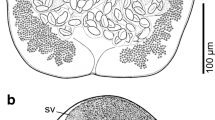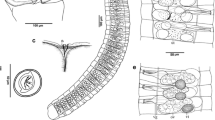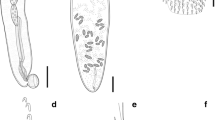Abstract
A new species, Paranoplocephala buryatiensis n. sp. (Cestoda:Anoplocephalidae), is described from the grey-sided vole Clethrionomys rufocanus (Sundevall) in the Republic of Buryatia (Russian Federation) and compared with P. longivaginata Chechulin & Gulyaev, 1998, a parasite of the red vole C. rutilus (Pallas) in the same region. P. buryatiensis n. sp. and P. longivaginata both have an exceptionally long vagina and cirrus, unique features among known species of Paranoplocephala Lühe, 1910. The new species differs from P. longivaginata primarily by its wider and more robust body, lower length/width ratio of mature proglottides, tendency of testes to occur in two separate groups, seminal receptacle of a different shape and the position of the cirrus-sac with respect to the ventral longitudinal osmoregulatory canal. The cytochrome oxidase subunit I (COI) sequence data support the independent status of these species, and show that they form a monophyletic assemblage within Paranoplocephala (sensu lato). Assuming cospeciation, an indirect calibration using host speciation dates estimated a rate of mtDNA substitution of 1.0–1.7% pairwise (0.5–0.85% per lineage) sequence divergence per million years. A faunistic review of Paranoplocephala species in C. rufocanus and C. rutilus in the Holarctic region is presented.
Similar content being viewed by others
References
Asakawa, M. (1989). Helminth fauna of Japanese Microtidae and Muridae. Honyurui Kagaku (Mammalian Science), 29, 17–35 (in Japanese)
Asakawa, M., Harada, M. (1989). Faunal and zoogeographical study on the internal parasites of the Japanese red-backed volve [sic], Eothenomys spp. Bulletin of the Biogeographical Society of Japan, 44, 199–210 (in Japanese)
Asakawa, M., Yokoyama, Y., Fukumoto, S., & Ueda, A. (1983). A study of the internal parasites of Clethrionomys rufocanus bedfordiae (Thomas). Japanese Journal of Parasitology, 32, 399–411
Ba, C. T., Wang, X. Q., Renaud, F., Euzet, L., Marchand, B., & De-Meeus, T. (1993). Diversity and specificity in cestodes of the genus Moniezia: Genetic evidence. International Journal for Parasitology, 23, 853–857
Baverstock, P. R., Adams, M., & Beveridge, I. (1985). Biochemical differentiation in bile duct cestodes and their marsupial hosts. Molecular Biology and Evolution, 2, 321–337
Brunhoff, C., Galbreath, K. E., Fedorov, V. B., Cook, J. A., & Jaarola, M. (2003). Holarctic phylogeography of the root vole (Microtus oeconomus): Implications for late Quaternary biogeography of high latitudes. Molecular Ecology, 12, 957–968
Chaline, J., & Graf, J. D. (1988). Phylogeny of the Arvicolidae (Rodentia): Biochemical and paleontological evidence. Journal of Mammalogy, 69, 22–33
Chechulin, A. I., & Gulyaev, V. D. (1998). Paranoplocephala longivaginata sp. n. (Cyclophyllidea: Anoplocephalidae) - a new cestode from rodents of the Western Siberia. Parazitologiya, 32, 352–356 (in Russian)
Conroy, C. J., & Cook, J. A. (1999). MtDNA evidence for repeated pulses of speciation within arvicoline and murid rodents. Journal of Mammalian Evolution, 6, 221–245
Cook, J. A., Runck, A. M., & Conroy, C. J. (2004). Historical biogeography at the crossroads of the northern continents: Molecular phylogenetics of red-backed voles (Rodentia: Arvicolinae). Molecular Phylogenetics and Evolution, 30, 767–777
Egorova, T. P. & Nadtochii, E. V. (1975). [Helminths of some rodents of the Kolyma Mountains.] In: Gel’mintologicheskie Issledovaniya Zivotnyh i Rastenii. (Trudy Biologo – Pochvennogo Insitituta ANSSSR), Vol. 26, pp. 33–45 (in Russian)
Felsenstein, J. (1985). Confidence limits on phylogenies: An approach using the bootstrap. Evolution 39, 783–791.
Galbreath, K. E., & Cook, J. A. (2004). Genetic consequences of Pleistocene glaciations for the tundra vole (Microtus oeconomus) in Beringia. Molecular Ecology, 13, 135–148
Goldman, N. (1993). Statistical test of models of DNA substitution. Journal of Molecular Evolution, 36, 182–198
Gubanov, N. M., & Fedorov, K. P. (1970). Helminth fauna of mouse-like rodents in Yakutia. In: Cherepanov, A.I. (Eds.), Fauna Sibirii (pp. 18–47). Nauka: Novosibirsk, (in Russian)
Hafner, M. S., & Page, R. D. M. (1995). Molecular phylogenies and host-parasite cospeciation – gophers and lice as a model system. Philosophical Transactions of the Royal Society of London – Series B: Biological Sciences, 349, 77–83
Hasegawa, M., Kishino, H., & Yano, T. (1985). Dating the human-ape splitting by a molecular clock of mitochondrial DNA. Journal of Molecular Evolution, 22, 160–174
Haukisalmi, V. (1986). Frequency distributions of helminths in microtine rodents in Finnish Lapland. Annales Zoologici Fennici, 23, 141–150
Haukisalmi, V., & Henttonen, H. (1999). Determinants of helminth aggregation in natural host populations: Individual differences or spatial heterogeneity?. Ecography, 22, 629–636
Haukisalmi V., & Henttonen H. (2001). Biogeography of helminth parasitism in Lemmus Link (Arvicolinae), with the description of Paranoplocephala fellmani n. sp. (Cestoda: Anoplocephalidae) from the Norwegian lemming L. lemmus (Linnaeus). Systematic Parasitology, 49, 7–22
Haukisalmi, V., & Henttonen, H. (2003). What is Paranoplocephala macrocephala (Douthitt, 1915) (Cestoda: Anoplocephalidae)?. Systematic Parasitology, 54, 53–69
Haukisalmi, V., & Henttonen, H. (2005). Description of Paranoplocephala yoccozi n. sp. (Cestoda: Anoplocephalidae) from the snow vole Chionomys nivalis in France, with a review of anoplocephalid cestodes of snow voles in Europe. Parasite, 12, 203–211
Haukisalmi, V., Henttonen, H. & Hardman, L. M. (2006). Taxonomy and diversity of Paranoplocephala spp. (Cestoda: Anoplocephalidae) in voles and lemmings of Beringia, with a description of three new species. Biological Journal of the Linnean Society, in press
Haukisalmi, V., Henttonen, H., Niemimaa, J., & Rausch, R. L. (2002). Description of Paranoplocephala etholeni n. sp. (Cestoda: Anoplocephalidae) in the meadow vole Microtus pennsylvanicus, with a synopsis of Paranoplocephala s.l. in Holarctic rodents. Parasite 9, 305–314
Haukisalmi, V., Henttonen, H., & Tenora, F. (1987). Parasitism by helminths in the grey-sided vole (Clethrionomys rufocanus) in northern Finland: Influence of density, habitat and sex of the host. Journal of Wildlife Diseases, 23, 233–241
Haukisalmi, V., & Wickström, L. M. (2005). Morphological characterisation of Andrya Railliet, 1893, Neandrya n. g. and Paranoplocephala Lühe, 1910 (Cestoda: Anoplocephalidae) in rodents and lagomorphs. Systematic Parasitology, 62, 209–219
Haukisalmi, V., Wickström, L. M., Henttonen, H., Hantula, J., & Gubányi, A. (2004). Molecular and morphological evidence for multiple species within Paranoplocephala omphalodes (Cestoda, Anoplocephalidae) in Microtus voles (Arvicolinae). Zoologica Scripta, 33, 277–290
Hoberg, E. P., Kutz, S. J., Galbreath, K. E., & Cook, J. A. (2003). Arctic biodiversity: From discovery to faunal baselines - revealing the history of a dynamic ecosystem. Journal of Parasitology, 89(Supplement), S84–S95.
Hu, M., Gasser, R. B., Chilton, N. B., & Beveridge, I. (2005). Genetic variation in the mitochondrial cytochrome c oxidase subunit 1 within three species of Progamotaenia (Cestoda: Anoplocephalidae) from macropodid marsupials. Parasitology, 130, 117–129.
Iwasa, M. A., Kartavtseva, I. V., Dobrotvorsky, A. K., Panov, V. V., & Suzuki, H. (2002). Local differentiation of Clethrionomys rutilus in northeastern Asia inferred from mitochondrial gene sequences. Mammalian Biology, 67, 157–166
Iwasa, M. A., Utsumi, Y., Nakata, K., Kartavtseva, I. V., Nevedomskaya, I. A., Kondoh, N., & Suzuki, H. (2000). Geographic patterns of cytochrome b and Sry gene lineages in the gray red-backed vole Clethrionomys rufocanus from Far East Asia including Sakhalin and Hokkaido. Zoological Science, 17, 477–484
Jeon, H. K., Lee, K. H., Kim, K. H., Hwang, U. W., & Eom, K. S. (2005). Complete sequence and structure of the mitochondrial genome of the human tapeworm, Taenia asiatica (Platyhelminthes; Cestoda). Parasitology, 130, 717–726
Lanave, C., Preparata, G., Saccone, C., & Serio, G. (1984). A new method for calculating evolutionary substitution rates. Journal of Molecular Evolution, 20, 86–93
Le, T. H., Pearson, M. S., Blair, D., Dai, N., Zhang, L. H., & McManus, D. P. (2002). Complete mitochondrial genomes confirm the distinctiveness of the horse-dog and sheep-dog strains of Echinococcus granulosus. Parasitology, 124, 97–112
Luo, J., Yang, D., Suzuki, H., Wang, Y., Chen, W.-J., Campbell, K. L., & Zhang, Y. (2004). Molecular phylogeny and biogeography of Oriental voles: Genus Eothenomys (Muridae, Mammalia). Molecular Phylogenetics and Evolution, 33, 349–362
Maddison, D. R., & Maddison, W. P. (2000). MacClade 4: Analysis of phylogeny and character evolution, version 4.0. Sunderland, MA: Sinauer Associates
Nakao, M., Sako, Y., & Ito, A. (2003). The mitochondrial genome of the tapeworm Taenia solium: A finding of the abbreviated stop codon U. Journal of Parasitology, 89, 633–635
Nakao, M., Sako, Y., Yokoyama, N., Fukunaga, M., & Ito, A. (2000). Mitochondrial genetic code in cestodes. Molecular Biochemistry and Parasitology, 111, 415–424
Paterson, A. M., & Gray, R. D. (1997). Host-parasite cospeciation, host switching, and missing the boat. In: Clayton, D. H., Moore, J. (Eds), Host-parasite evolution: General principles and avian models (pp. 236–250). Oxford: Oxford University Press
Posada, D., & Crandall, K. A. (1998). Modeltest: testing the model of DNA substitution. Bioinformatics, 14, 817–818.
Ryzhikov, K. M., Gvozdev, E. V., Tokobaev, M. M., Shaldybin, L. S., Macaberidze, G. V., Merkusheva, I. V., Nadtochii, E. V., Hohlova, I. G., & Sharpilo, L. D. (1978). [Keys to the helminths of the rodent fauna of the USSR. Cestodes and trematodes]. Nauka: Moskva, p 231 (in Russian).
Sanderson, M. J. (1998). Estimating rate and time in molecular phylogenies: Beyond the molecular clock. In: Soltis, D. E., Soltis, P. S., & Doyle, J. J. (Eds), Molecular systematics of plants II: DNA sequencing, (pp. 242–264). Massachusetts: Kluwer Academic Publishers
Sato, H., Kamiya, H., Tenora, F., & Kamiya, M. (1993). Anoplocephaloides dentatoides sp. n. from the gray-backed vole, Clethrionomys rufocanus bedfordiae, in Hokkaido, Japan. Journal of the Helminthological Society of Washington, 60, 105–110
Swofford, D. L. (2002). PAUP* Phylogenetic Analysis Using Parsimony (*and Other Methods), version 4. Sunderland, Massachusetts: Sinauer Associates
Telford, M. J., Herniou, E. A., Russell, R. B., & Littlewood, D. T. J. (2000). Changes in mitochondrial genetic codes as phylogenetic characters: Two examples from the flatworms. Proceedings of the National Academy of Sciences, USA, 97, 11359–11364
Tenora, F., Haukisalmi, V., & Henttonen, H. (1985). Andrya kalelai sp. n. and (?) Anoplocephaloides sp., Cestoda, Anoplocephalidae, parasites of Clethrionomys-rodents in Finland. Annales Zoologici Fennici, 22, 411–416
Tenora, F., & Murai, É. (1980). The genera Anoplocephaloides and Paranoplocephala (Cestoda) parasites of Rodentia in Europe. Acta Zoologica Academiae Scientiarum Hungaricae, 26, 263–284
Tenora, F., Murai, É., & Vaucher, C. (1986). On Andrya Railliet, 1893 and Paranoplocephala Lühe, 1910 (Cestoda, Monieziinae). Parasitologica Hungarica, 19, 43–75
Thompson, J. D., Higgins, D. G., & Gibson, T. J. (1994). CLUSTAL W: Improving the sensitivity of progressive multiple sequence alignment through sequence weighting, position-specific gap penalties and weight matrix choice. Nucleic Acids Research, 22, 4673–4680
von Nickisch-Rosenegk, M., Brown, W. M., & Boore, J. L. (2001). Complete sequence of the mitochondrial genome of the tapeworm Hymenolepis diminuta: Gene arrangements indicate that Platyhelminths are Eutrochozoans. Molecular Biology and Evolution, 18, 721–730
Wickström, L. M., Haukisalmi, V., Varis, S., Hantula, J., Fedorov, V. B., & Henttonen, H. (2003). Phylogeography of the circumpolar Paranoplocephala arctica species complex (Cestoda: Anoplocephalidae) parasitizing collared lemmings (Dicrostonyx spp.). Molecular Ecology, 12, 3359–3371
Wickström, L. M., Haukisalmi, V., Varis, S., Hantula, J., & Henttonen, H. (2005). Molecular phylogeny and systematics of anoplocephaline cestodes in rodents and lagomorphs. Systematic Parasitology, 62, 83–99
Yushkov, V. F. (1995). [Helminths of mammals.] In: [Fauna of the European North-East of Russia.] St. Petersburg: Rossiiskaya Akademiya Nauk, Vol. 3, pp. 203
Acknowledgements
Helminth collections in Buryatia were made in connection with a joint Finnish-Buryatian research project on rodent-borne viral zoonoses, funded by the University of Helsinki (grant TA 715321, project 2103039, to Olli Vapalahti). We are grateful to our local collaborators, most of all Galina Murueva, Zoya Yampilova and Stanislav Suhunov. Our research on molecular systematics of cestodes has been funded primarily by the Research Council for Biosciences and Environment, Finnish Academy (grants 40813 and 50474 to H.H. and a post-doctoral fellowship 108372 to L.M.H). We wish to thank Joseph A. Cook and Eric P. Hoberg for cooperation, support and access to the cestode materials collected in connection with the Beringian Coevolution Project (funding from the US National Park Service and National Science Foundation, DEB 0196095 and 0415668). E.P. Hoberg and Patricia Pilitt have kindly helped in the examination and deposition of specimens at the USNPC. Our thanks are also due to Antti Lavikainen, Eva Kallio, Pekka Niemelä and members of the various BCP crews for vole and cestode samples, often collected under challenging conditions.
Author information
Authors and Affiliations
Corresponding author
Rights and permissions
About this article
Cite this article
Haukisalmi, V., Hardman, L.M., Hardman, M. et al. Morphological and molecular characterisation of Paranoplocephala buryatiensis n. sp. and P. longivaginata Chechulin & Gulyaev, 1998 (Cestoda: Anoplocephalidae) in voles of the genus Clethrionomys . Syst Parasitol 66, 55–71 (2007). https://doi.org/10.1007/s11230-006-9059-1
Received:
Accepted:
Published:
Issue Date:
DOI: https://doi.org/10.1007/s11230-006-9059-1




